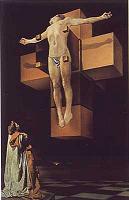An Offer He Couldn't Refuse
Today's birthday: Francis Ford Coppola is 64.
"There is a pleasantly discursive treatment
of Pontius Pilate's unanswered question
'What is truth?'."
— H. S. M. Coxeter, 1987, introduction to Richard J. Trudeau's remarks on the "Story Theory" of truth as opposed to the "Diamond Theory" of truth in The Non-Euclidean Revolution
"Then came From Here to Eternity. Sinatra lobbied hard for the role, practically getting on his knees to secure the role of the street smart punk G.I. Maggio. He sensed this was a role that could revive his career, and his instincts were right. There are lots of stories about how Columbia Studio head Harry Cohn was convinced to give the role to Sinatra, the most famous of which is expanded upon in the horse's head sequence in The Godfather. Maybe no one will know the truth about that. The one truth we do know is that the feisty New Jersey actor won the Academy Award as Best Supporting Actor for his work in From Here to Eternity. It was no looking back from then on."
From a note on geometry of April 28, 1985:

Art
Wars:
Mathematics and the
Emperor's New Art
From Maureen Dowd's New York Times column of June 9, 2002:
"The shape of the government is not as important as the policy of the government. If he makes the policy aggressive and pre-emptive, the president can conduct the war on terror from the National Gallery of Art."
|
NY Times, April 5,
2003: |
|
Meanwhile, at the Washington Post, another example of great determination and strength of character:
Donald Coxeter Dies: Leader in Geometry
By Martin Weil
Washington Post
Staff Writer
Saturday, April 5, 2003
"Donald Coxeter, 96, a mathematician who was one of the 20th century's foremost specialists in geometry and a man of great determination and strength of character as well, died March 31 at his home in Toronto."
From another Coxeter obituary:
In the Second World War, Coxeter was asked by the American government to work in Washington as a code-breaker. He accepted, but then backed out, partly because of his pacifist views and partly for aesthetic reasons: "The work didn't really appeal to me," he explained; "it was a different sort of mathematics."
For a differing account of how geometry is related to code-breaking, see the "Singer 7-cycle" link in yesterday's entry, "The Eight," of 3:33 PM. This leads to a site titled
An Introduction to the
Applications of Geometry in
Cryptography.
"Now I have precisely the right instrument, at precisely the right moment of history, in exactly the right place."
— "Patton,"
the film

Added Sunday, April 6, 2003, 3:17 PM:
The New York Times Magazine of
April 6
continues this Art Wars theme.

(Cover typography
revised)
The military nature of our Art Wars theme appears in the Times's choice of words for its cover headline: "The Greatest Generation." (This headline appears in the paper, but not the Internet, version.)
Some remarks in today's Times Magazine article seem especially relevant to my journal entry for Michelangelo's birthday, March 6.
"...Conceptualism — suddenly art could be nothing more than an idea....
LeWitt moved between his syntax of geometric sculptures and mental propositions for images: concepts he wrote on paper that could be realized by him or someone else or not at all. Physical things are perishable. Ideas need not be."
— Michael Kimmelman, chief art critic of the New York Times, April 6, 2003
Compare this with a mathematician's aesthetics:
"A mathematician, like a painter or a poet, is a maker of patterns. If his patterns are more permanent than theirs, it is because they are made with ideas."
— G. H. Hardy, A Mathematician's Apology (1940), reprinted 1969, Cambridge U. Press, p. 84
It seems clear from these two quotations that the real conceptual art is mathematics and that Kimmelman is peddling the emperor's new clothes.
The Eight
Today, the fourth day of the fourth month, plays an important part in Katherine Neville's The Eight. Let us honor this work, perhaps the greatest bad novel of the twentieth century, by reflecting on some properties of the number eight. Consider eight rectangular cells arranged in an array of four rows and two columns. Let us label these cells with coordinates, then apply a permutation.
|
|
|
|
|
The resulting set of arrows that indicate the movement of cells in a permutation (known as a Singer 7-cycle) outlines rather neatly, in view of the chess theme of The Eight, a knight. This makes as much sense as anything in Neville's fiction, and has the merit of being based on fact. It also, albeit rather crudely, illustrates the "Mathematics and Art" theme of this year's Mathematics Awareness Month. (See the 4:36 PM entry.)
The visual appearance of the "knight" permutation is less important than the fact that it leads to a construction (due to R. T. Curtis) of the Mathieu group M24 (via the Curtis Miracle Octad Generator), which in turn leads logically to the Monster group and to related "moonshine" investigations in the theory of modular functions. See also "Pieces of Eight," by Robert L. Griess.
ART WARS:
Art at the Vanishing Point
Two readings from The New York Times Book Review of Sunday,
2003 are relevant to our recurring "art wars" theme. The essay on Dante by Judith Shulevitz on page 31 recalls his "point at which all times are present." (See my March 7 entry.) On page 12 there is a review of a novel about the alleged "high culture" of the New York art world. The novel is centered on Leo Hertzberg, a fictional Columbia University art historian. From Janet Burroway's review of What I Loved, by Siri Hustvedt:"...the 'zeros' who inhabit the book... dramatize its speculations about the self.... the spectator who is 'the true vanishing point, the pinprick in the canvas.'''
Here is a canvas by Richard McGuire for April Fools' Day 1995, illustrating such a spectator.

For more on the "vanishing point," or "point at infinity," see
Connoisseurs of ArtSpeak may appreciate Burroway's summary of Hustvedt's prose: "...her real canvas is philosophical, and here she explores the nature of identity in a structure of crystalline complexity."
For another "structure of crystalline
complexity," see my March 6 entry,
"Geometry for
Jews."
For a more honest account of the
New York art scene, see Tom Wolfe's
The Painted
Word.
Lovely, Dark and Deep

On this date in 1923, "Stopping by Woods on a Snowy Evening," by Robert Frost, was published. On this date in 1999, director Stanley Kubrick died. On this date in 1872, Piet Mondrian was born.
"....mirando il punto
a cui tutti li tempi son presenti"
— Dante, Paradiso, XVII, 17-18

Chez Mondrian
Kertész, Paris, 1926
 6:23 PM Friday, March 7:
6:23 PM Friday, March 7:
From Measure Theory, by Paul R. Halmos, Van Nostrand, 1950:
"The
symbol ![]() is used throughout the entire book in place of such phrases
as 'Q.E.D.' or 'This completes the proof of the theorem' to
signal the end of a proof."
is used throughout the entire book in place of such phrases
as 'Q.E.D.' or 'This completes the proof of the theorem' to
signal the end of a proof."
ART WARS:
Geometry for Jews
Today is Michelangelo's birthday.
Those who prefer the Sistine Chapel to the Rothko Chapel may invite their Jewish friends to answer the following essay question:

Discuss the geometry underlying the above picture. How is this geometry related to the work of Jewish artist Sol LeWitt? How is it related to the work of Aryan artist Ernst Witt? How is it related to the Griess "Monster" sporadic simple group whose elements number
808 017 424 794 512 875 886 459 904 961 710 757 005 754 368 000 000 000?
Some background:
-
From Nobel Prize Women in Science, by Sharon Bertsch McGrayne, Second Edition (2001), Joseph Henry Press:
"Storm trooper Ernst Witt, resplendent in the Brownshirt uniform of Hitler's paramilitary, knocked on a Jew's apartment door in 1934. A short, rotund woman opened the door. Emmy Noether smiled, welcomed the young Nazi into her home, and started her underground math class. The Brownshirt was one of her favorite pupils."
-
On this date in 1962, Frank Sinatra recorded "I Gotta Right To Sing The Blues" for Capitol Records. This was his last recording for Capitol. He had already started recording for Reprise Records.
-
Related reading:
- A Beauty Really Bare, by Robert Hughes, and
- The Painted Word, by Tom Wolfe
Song of Not-Self
A critic on the abstract expressionists:
"...they painted that reality -- that song of self -- with a passion, bravura, and decisiveness unequaled in modern art."
Painter Mark Rothko:
"I don't express myself in painting.
I express my not-self."
On this day in 1957, Buddy Holly and his group recorded the hit version of "That'll Be the Day."
On this day in 1970, painter Mark Rothko committed suicide in his New York City studio.
On February 27, 1971, the Rothko Chapel was formally dedicated in Houston, Texas.
On May 26, 1971, Don McLean recorded "American Pie."
Rothko was apparently an alcoholic; whether he spent his last day enacting McLean's lyrics I do not know.
Rothko is said to have written that
"The progression of a painter's work, as it travels in time from point to point, will be toward clarity: toward the elimination of all obstacles between the painter and the idea, and between the idea and the observer. As examples of such obstacles, I give (among others) memory, history or geometry, which are swamps of generalization from which one might pull out parodies of ideas (which are ghosts) but never an idea in itself. To achieve this clarity is, inevitably, to be understood."
-- Mark Rothko, The Tiger's Eye, 1, no. 9 (October 1949), p. 114
Whether Holly's concept "the day that I die" is a mere parody of an idea or "an idea in itself," the reader may judge. The reader may also judge the wisdom of building a chapel to illustrate the clarity of thought processes such as Rothko's in 1949. I personally feel that someone who can call geometry a "swamp" may not be the best guide to religious meditation.
For another view, see this essay by Erik Anderson Reece.
Update of June 1, 2003 --
For an example of geometry as conceptual art, see
The Eightfold Way and Solomon's Seal.
Update of June 4, 2003 --
For more on Kimmelman peddling the emperor's new clothes, see an
essay by Roger Kimball,
Update of July 13, 2003 --
For material on the origin of minimalist art, Frank Stella,
Derrida, and curator Dorothy Miller, see
Update of August 16, 2003 --
For a sequel to "The Word in the Desert" (previous link), see
Update of August 17, 2003 --
For a sequel to "Varnedoe's Crown" that memorializes Claude
Martel, a New York Times Magazine art director who also died on
the day of the Great Blackout, see
Update of October 3, 2003 --
For remarks by art theorist Rosalind Krauss on narrative, time,
and the grid as a timeless structure, and related remarks by T.
S. Eliot on time and timelessness, see
Update of October 24, 2003 --
Closely related to Art Wars:
Defense Secretary Rumsfeld's "War of Ideas." See
Update of February 8, 2004 --
Notes on Hans-Georg Gadamer's philosophy of art as applied to the
Update of February 17, 2004 --
Notes on the geometry underlying quilt blocks, with link to the
related work on perceptual theory of James J. Gibson... See
Block Designs in Art and Mathematics.
Update of Ash Wednesday, February 25, 2004 --
Notes on what might be called "the religion of Cubism" as
proclaimed by Yale University Press and others... See
Update of Saturday, February 28, 2004 --
The above ART WARS material involves a notable issue of the New
York Times Magazine. For discussion of another notable issue,
see the Feb. 28, 2004, obituary of the style editor of the
Times Magazine. For some philosophical background to that
obituary, see
Truth and Style:
ART WARS at Harvard.
Update of March 5, 2004 --
The concept of "cognitive blending" ties together much of the
above material. For a seminal paper on this topic, see
Gilles Fauconnier and Mark Turner,
"Conceptual Integration Networks"
(Cognitive Science, 22(2) 1998, 133-187)
For an application to the way
life can blend with fiction, see
Update of April 2, 2004 --
Two New York Times reviews today are relevant to the themes of
ART WARS:
Minimal Art, by Michael Kimmelman
Hannah and Martin, by Margo Jefferson.
The themes of these reviews -- a minimalist dividing line, and polar opposites -- are combined in my March 15 page,
Update of April 6, 2004 --
For Kimmelman vs. Kimball on ideas in art, with commentary by
Wallace Stevens and Rene Descartes, see
Update of April 7, 2004 (First anniversary of Art
In memory of architect Pierre Koenig:
Mother of Beauty: A Note on Modernism.
Update of May 27, 2005--
Journal entries suggested by a scheduled July conference in Mykonos:
Update of June 19, 2005--
Darkness Visible
"No light, but rather darkness visible
Serv'd only to discover sights of woe"
-- John Milton, Paradise Lost,
Book I, lines 63-64
summarizes the art of Ad Reinhardt
(Adolph Dietrich Friedrich Reinhardt,
Dec. 24, 1913 - Aug. 30, 1967):
Fade to Black "...that ineffable constellation of talents that makes the player of rank: a gift for conceiving abstract schematic possibilities; a sense of mathematical poetry in the light of which the infinite chaos of probability and permutation is crystallized under the pressure of intense concentration into geometric blossoms; the ruthless focus of force on the subtlest weakness of an opponent." -- Trevanian, Shibumi "'Haven't there been splendidly elegant colors in Japan since ancient times?' 'Even black has various subtle shades,' Sosuke nodded." -- Yasunari Kawabata, The Old CapitalAn Ad Reinhardt painting
Ad Reinhardt, The viewer may need to tilt "The grid is a staircase to the Universal.... We could think about Ad Reinhardt, who, despite his repeated insistence that 'Art is art,' ended up by painting a series of... nine-square grids in which the motif that inescapably emerges is a Greek cross. 
Greek Cross There is no painter in the West who can be unaware of the symbolic power of the cruciform shape and the Pandora's box of spiritual reference that is opened once one uses it." -- Rosalind Krauss,
|
In memory of
St. William Golding
(Sept. 19, 1911 - June 19, 1993)
Update of June 20, 2005--
Art History
"I studied with Reinhardt and I found
that a fantastic course. I think he was really very stimulating....
Art history was very personal through the eyes of Ad Reinhardt."
-- Robert Morris,
Smithsonian Archives of American Art
Related material:
“The Road to Simplicity Followed by Merton’s Friends: Ad Reinhardt and Robert Lax” in The Merton Annual 13 (2000) 245-256, by Paul J. Spaeth, library director at St. Bonaventure University
The Merton here is Trappist monk Thomas Merton. Here is Merton in a letter to poet Robert Lax on the death of their friend Ad Reinhardt, sometimes called the “black monk” of abstract art:
"Make Mass beautiful silence like big black picture speaking requiem. Tears in the shadows of hermit hatch requiems blue black tone. Sorrows for Ad in the oblation quiet peace request rest. Tomorrow is solemns in the hermit hatch for old lutheran reinhardt commie paintblack… Tomorrow is the eternal solemns and the barefoots and the ashes and the masses, oldstyle liturgy masses without the colonels… Just old black quiet requiems in hermit hatch with decent sorrows good by college chum."
-- from J. S. Porter, "Farewell to a Monk,"
Antigonish Review, Winter 1997








